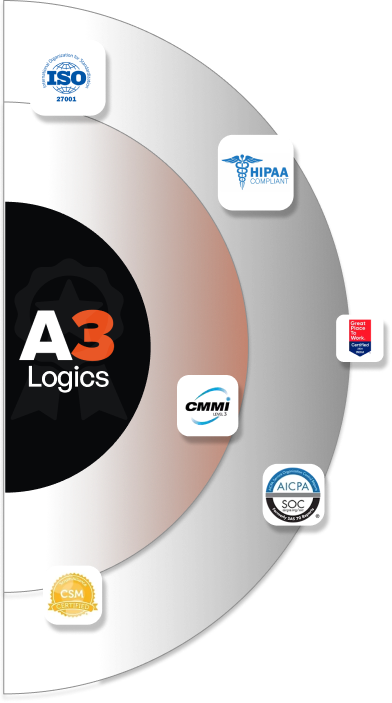Inventory management is key for all organizations, no matter their size or type. They must keep track of their stock items, which could be anything from items that sell slowly to those in high demand. To do this, businesses use special database systems, also known as inventory management software.
But, there are things you should know before working with an expert in inventory management software development. Not all inventory management tools are the same, so understanding what’s involved in inventory management software can help you make the best choice for your business.
Putting money into inventory management software isn’t just about getting a tool for stock tracking. It’s about creating a complete solution that works well with your current systems, understands your inventory issues, and helps you reach the best inventory levels. This makes sure you keep a good balance, avoiding running out of stock or having too much, and makes your warehouse management tasks more efficient.
Working with capable inventory management software development companies can help you create a custom solution made especially for the unique needs of your warehouse management operations. This custom software not only makes things run smoother but also lowers the chances of mistakes, leading to improved business results.
Table of Contents
What is Inventory Management Management Software?
Inventory management software development is all about crafting platforms. These tools help firms to watch over the movement of items into and out of their warehouses with ease. It’s a smart bit of software that spans the full spectrum of the product inventory cycle. From when it’s made, stored in the warehouse, right up to its final delivery, this tool has got it covered.
Made by skilled teams from inventory management software companies, this crucial tool is a mainstay in the world of shipping logistics software. These software solutions offer an all-in-one platform that lets you stay on top of every important item in your inventory. It’s like a virtual peek into the complex network of logistics and inventory management. It’s built with the clear aim of tracking every single movement of your inventory items.
Built by a professional inventory management software development company, these software tools consider not just the functional needs but also the company’s business model. This makes sure that the software offers a complete solution for managing goods. It ensures a steady flow of products from the warehouse to the delivery spot.
In a world where doing things fast and right is key, the rise of inventory management software development has really changed the inventory management process. With a sharp eye on every single item in your inventory, you’ll never lose sight of a single bit of your inventory puzzle. This is all thanks to these clever software solutions made by seasoned teams from inventory management software companies.
How does it work?
Well, inventory management software, typically made as a solo tool or as part of a bigger business ERP tool, makes the tough chores linked to inventory handling more streamlined.
In the field of inventory management software, these tools are usually built to cooperate seamlessly with up-to-date implements like RFID tags and barcode scanners. The main job of these implements is to grab precise details about each order item. This data is then stored in an orderly manner in the software, aiding in the careful organization of inventory records.
The brilliant simplicity with which warehouse staff can find order items and tweak the inventory count speaks volumes about the strength of top-notch inventory management systems software development services. This doesn’t just make the chores easier but also cuts down the chance for human mistakes, enhancing overall effectiveness in the process.
What really makes this tool shine in practical use, however, is its real-time item-tracking feature. In a busy warehouse, keeping up-to-date with the real-time spot and status of each item is crucial. Thanks to progress in inventory management software development, this is now doable, offering a smooth way to keep tabs on every bit of inventory in real time.
Inventory Management Software Market: Trends and Statistics
Research from GMInsights delivers intriguing insights into the rapidly growing Inventory Management Software market. By 2025, this market’s worldwide value is expected to rocket to a staggering $5 billion, a significant leap from the $3 billion level achieved in 2019.
Similarly, predictions suggest that the global warehouse inventory management software arena will be a critical revenue contributor. It’s set to generate a massive $394 million by the end of 2020.
One key trend that stands out is the powerful impact of inventory management software on boosting business income and expansion. Approximately 36% of supply chain professionals staunchly uphold this view. They stress that using advanced software solutions is a must-do strategy for maximizing inventory, thereby fueling business success.
Additionally, firms see measurable gains, with a 25% rise in productivity after deploying Inventory Management Software (IMS). Simultaneously, supply chain companies have noticed a 30% improvement in their stock efficiency, a direct outcome of using IMS.
In today’s business landscape, it’s evident that there’s a marked trend toward investing in inventory management software development. The rationale is straightforward: this technology enables companies to remove any present supply chain hitches. It achieves this through the centralization and coordination of operations provided by IMS.
Furthermore, the surging demand for Custom Software Development Services is another significant trend. These bespoke solutions offer a competitive advantage, equipping businesses with customized systems to meet their specific operational needs. They are being increasingly used in the supply chain sector to enhance sales productivity and order frequency, thereby making the process more streamlined and efficient.
Types of Inventory Management Software Solutions
Human-driven systems
Such software leans on human input for complex calculations. Perfect for smaller businesses with less inventory and operations, these systems work well. But, when things get more complex, reliability may slide, causing mistakes. This is where custom software development companies in the USA come into play. They offer made-to-measure solutions, lowering error chances and making processes smoother.
Barcode scanning
Research shows about 45% of US firms use barcode systems within their inventory management setups. This software allows them to handle a lot of items, gathering info from the Point of Sale (POS) and registers. As a mainstay in the inventory management software development arena, these sturdy systems update inventory each time an item is scanned, boosting work efficiency.
Advanced RFID systems
Big companies often opt for advanced RFID (Radio Frequency Identification) systems as a core part of their inventory software development plan. These systems allow swift scanning of numerous items with a high accuracy level. As items enter or leave the inventory, the stock level updates. An RFID reader captures these details via RFID tags. These systems are unique as they can scan out-of-view items and alter data in real-time. So, more custom software development companies are focusing on adding RFID tech into their software solutions because of their accuracy and adaptability.
Essential Features of Inventory Management Software
List Items
This feature is used to capture and store stock details like availability, cost, price, and so on. Employees can arrange items systematically with this function.
Track Items
Products inside inventory or warehouses are tracked using this feature via barcode, serial number, or RFID tags.
Reorder Items
Inventory items required urgently for pick, pick, and dispatch can be tracked easily using this feature while updating the stock lists.
Logistics Management
This feature allows data syncing with third-party logistics and transportation management software for better transparency in SCM.
Track Raw Materials
This feature lets inventory staff track the availability of new material for production.
Reports and Analytics
Using this feature offers a holistic view of inventory with details like stock levels, profitability, sales trends, and more.
Integrations
This feature allows IMS integration with other useful business tools like CRM, ERP, HCM, and more. It ensures seamless data exchange for accurate inventory operations.
Cloud-storage
Cloud-based apps or software ensure robust data security and on-the-go accessibility for inventory management.
Manage Vendors
This feature lets users add, update, and delete vendors from the database. Companies can avoid costly errors with updated databases.
Low-stock alerts
This feature allows inventory staff to when an item quantity goes behind the preset threshold level via system alert, notification, or email.
Stock refilling
This feature passes automatic refilling instructions when an inventory item is near its minimum level.
Barcode Scan
Inventory staff scans items using barcodes when this feature is enabled.
Multi-location Support
When companies have warehouses operational at multiple places, this feature is enabled for accurate stock tracking and management.
Serial Number tracking
Inventory staff uses item serial numbers for inventory updates with this feature.
Inventory forecasting
To avoid out-of-stock and overstock circumstances, this feature is activated to predict the future demand for items using Artificial Intelligence, predictive analytics, and more.
Advantages of Inventory Management Software
Reduce Inventory Costs
One huge plus of inventory management software development is the potential to cut costs. How? Thanks to cloud technology, you can track and update your inventory data in real time across various devices. This means less money is spent on the usual admin work related to inventory.
Better Inventory Planning
Inventory Management Software, or IMS, can help those managing inventory to plan better. This becomes possible when you can record and manage your inventory items well, thus changing the game for ecommerce software development companies in the USA.
Higher Staff Productivity
An added benefit of IMS is a possible rise in staff productivity. By offering well-organized data and top-notch tracking choices, IMS lightens the admin load tied to inventory control. The result? Your team feels inspired to carry out key operational tasks more effectively.
Improved Forecasting
IMS is loaded with precise stock tracking, providing valuable help for planning ahead. It uses various data analytics tools, which are key to spotting market trends and chances for a range of products and services. This skill is crucial for ecommerce software development companies, helping them to stay in the game and remain up-to-date.
Increased Sales and Profitability
A well-planned IMS keeps an exact eye on stock levels, reducing the chances of mistakes in product tracking. This precision helps speed up product delivery, makes customers happy, and, in the end, boosts sales.
Robust Data Security
Another major plus of cloud-based inventory management software is the safety of your inventory data. All your inventory data is stored safely in the cloud, which cuts down on the risk of tech security gaps or data breaches. This strong security feature is important, particularly for ecommerce software development companies. It adds a lot to the reliability and trustworthiness of these platforms.
Cost of Building Inventory Management Software
When you decide to create your very own custom inventory management software, the price can range from a humble $20,000 to a heftier $40,000. The final cost depends mostly on how complex the software’s features need to be. That said, it’s crucial to understand the full price range for inventory management software development. If you’re looking to create a more complex system loaded with high-end features, the cost could leap from $40,000 to a whopping $80,000.
What drives this wide price range? A few factors come into play. Each has its own effect on the final price tag. We need to consider the technical aspects of the software development process, the software’s desired functionality, the total number of development hours required, and the skill level and location of your chosen software developers.
Here’s a word of caution: labor costs can vary greatly from region to region, and this can noticeably sway the overall cost of software development. For example, developers from the United States might start their hourly rate at a significant $200. That’s a lot more than what you’d usually pay for developers based in Asia, where rates start at a more pocket-friendly $40 per hour.
Hence, the cost of inventory management software development can change a lot. It mainly depends on your project’s specific needs and the team you choose to work with. So, having a clear understanding of these elements and planning ahead can help you budget better and ensure a smoother development process.
Inventory Management Software Development Process
Here’s a peek into the standard tasks that dedicated developers carry out during the process of inventory management software development:
- Conceptualization: This phase requires a crystal-clear grasp of the software’s wished-for features. Having a crisp picture of what you want your final product to look like is key. It aids you in clearly voicing your product requirements to your software development consulting company.
- Requirement Gathering & Analysis: At this point, the software development consulting company steps in to gather and study your software needs. The goal is to check the product’s real-world applicability and pinpoint the overall risk involved.
- Wireframing & Design: This phase includes creating several wireframes and rough drafts of your software, keeping the main features in mind. Your consulting partner shares these for your nod, helping you finalize the final design and structure of the product.
- Development/Implementation: This stage is where the dedicated developers really roll up their sleeves, diving into the core of the project. The overall functionality of the software is woven into the system during this phase.
- Rigorous Testing: After the development phase, the QA and testing team kicks into gear. Their job is to perform stringent testing to spot any functionality, usability, and performance glitches within the software. The product undergoes testing throughout the project after the end of every major task, ensuring quality development.
- Deployment/Maintenance: Finally, the crafted software is launched in the cloud or on-premise environment, as per the initial agreement. It’s followed by regular updates and aid to ensure smooth operations.
The journey of inventory management software development is a complex one. Thus, it’s key to team up with top software development consulting companies that grasp your vision and can bring it to life without a hitch.
Inventory Management Software: Build Vs. Buy Decision
Diving into the universe of inventory management software for your venture might feel like finding your way in a tricky maze. In this ‘make or purchase’ software conundrum, your choice should rightly hinge on your unique business wants, future plans, inventory-linked hurdles, and internal operational systems.
Being too relaxed about any of these vital parts could accidentally nudge you into crafting an Inventory Management Software (IMS) that falls short of your business requirements. Often, specialists suggest a tailored path to Inventory Management Software Development from the ground up. This tip stems from the significant flexibility it grants, forming ideally to fit your business’s distinct needs.
Yet, this journey of software building is not a solo one. You might need a trusty partner who can deliver robust eCommerce Software Solutions. These solutions serve as a sturdy base, enhancing your inventory management process while making it agile and adjustable. Finally, striking the right balance in the ‘make or purchase’ choice can lead to an IMS that morphs into the heart of your eCommerce Solutions, flawlessly attuned to your business’s daily tasks.
Reasons to Use Custom Inventory Software
- Flexibility: It gives you the option to build software that perfectly fits into your inventory workflow.
- Scalability: It has the potential for further enhancements as your business grows. Start small with MVP and later on add more features.
- Better Control: It allows you to control every part/element of your tool – from UI/UX to third-party integrations and more.
- Cost-effective: You don’t need to pay monthly subscription and licensing fees with custom IMS software.
- Data Security: Best encryption and data security practices are applied by outsourcing vendors to protect your business information.
Why Use Chatbots in Ecommerce Business
For any ecommerce business, managing inventory is key. Keeping track of inventory accurately avoids having too much or too little stock and helps predict demand. That’s where Inventory Management Software Development comes in. It does these tasks automatically, making things more efficient.
So, where do chatbots come in? When you connect a chatbot with an inventory management system, it can update inventory in real-time, answer stock queries and even handle orders. This all improves the customer’s shopping experience.
- Real-time Inventory Updates: Think about a customer wanting to know if an item is in stock. Instead of a person checking the inventory, a chatbot can quickly get this info from the connected inventory management system. This lowers the workload for the staff and gives customers quick answers, which can lead to happier customers and more sales.
- Enhanced Customer Interaction: Chatbots can chat with customers all day, every day. They can answer questions, suggest products and even help with paying. They can also keep track of how customers behave and give them a shopping experience that feels personal. In a time when making things personal keeps customers coming back, this feature is priceless.
- Cost-effective Solution: Even though starting with Software Development and chatbot integration might cost a bit, the benefits over time are clear. With automatic inventory management, better customer service, more sales, and lower staffing costs, the return on investment is high.
Retail & Ecommerce Software To Boost Your Business Sales
In the retail and ecommerce world, keeping an accurate inventory count is critical. Selling too much or too little because of wrong stock info can damage a business’s image and profits. This is when Inventory Management Software Development steps in. A well-built, efficient inventory management system keeps an eye on your stock in real-time, updates product availability, and avoids these problems. On top of that, it takes your staff away from manually managing inventory, letting them focus on strategic activities that drive sales.
Boosting Sales through Enhanced Customer Experience
Software for managing inventory boosts your sales by enhancing the customer’s journey. It’s a crucial thing customers look for – information about what you have in stock and when. An inventory management system gives customers this info on the spot. It helps them make smart buying choices. This leads to happy customers who keep coming back, and that means more sales for you.
Inventory management software does more than just track your goods. It gives you useful information that can shape your sales plan. By knowing what sells quickly, what’s slow to move, and what’s popular in different seasons, you can make smart choices. You can decide when to give discounts, when to promote items, and when to buy more stock – all of this will help boost your sales.
The Role of Other Retail & Ecommerce Software
Managing your inventory is important, but there are other software solutions that also help to boost your sales.
- CRM Software: This is a tool that helps you look after your customers. It keeps track of how customers behave, finds leads that may turn into sales, and helps you tailor your marketing to individual customers, which can help increase sales.
- POS Systems: These systems make the buying process smoother, faster, and more efficient. They also give you useful data on sales and help you control your inventory.
- Software for Marketing Automation: This software does routine marketing tasks for you, like sending emails or posting on social media. It leaves you free to focus on more strategic work to boost your sales.
- Ecommerce Platforms: This software is where you make your online sales. It offers useful features like shopping cart functions, handling payments, and compatibility with mobile devices.
Streamline your Business Operations and Maximize Efficiency with our Cutting-edge Inventory Management Software.
Ready to Integrate Inventory Management Software in Your Business?
We believe our clear guide has answered all your questions about inventory management system software. If you’re hunting for trustworthy, top-quality, custom inventory management software packed with first-class security features, your search ends at A3logics.
As a seasoned product engineering services firm, we offer over ten years of know-how in inventory management software development. Our journey has crossed many sectors, giving tailored solutions to match special needs. No wonder we’re proud to share our 99% client happiness score in software development.
Feel free to reach out to us to chat about your IMS project idea. With our strong skill set in inventory management software development, we’d be thrilled to lend a helping hand!
FAQs
What is Inventory Management Software Development?
Inventory Management Software Development is a special task. It aims to make digital tools that can help companies to keep a watchful eye on and take care of their inventory. It’s about writing code and making software apps that make the tough task of inventory management simple and automatic. The end goal? To give businesses a better way to look after their stocks, bring down running costs, make sure goods are always available, and in the end, boost efficiency and earnings.
How much does an inventory management system cost?
The total cost to build an inventory management software falls between $20000 to $40000 with basic features. For complex IMS, the cost boosts up to $80000 based on system complexity.
How to build inventory management software?
Consider the following development aspects carefully- project conceptualization, requirement analysis, wireframing & design, development, testing, deployment, and maintenance while building a tailored IMS solution. Partner with an experienced Inventory management enterprise software development company for the best results.
Which is the best software for inventory management?
Popular inventory management software includes Zoho Inventory, ecomdash, EZOfficeInventory, etc. For better control and flexibility in inventory operations, build custom software.
How to decide between building and buying Inventory Management Software?
Choosing to make or buy Inventory Management Software depends on your business needs, how much money you can spend, and your timeline. Buying ready-made software is often quicker and costs less at the start, but it might not match your business needs as closely as custom software. On the other side, making custom software needs a bigger investment and more time at the start, but it can give a better fit and more value in the long run.





